THE GENERALS’ WIVES
Three First Ladies Shaped by the Military
Martha Washington, Julia Grant, and Mamie Eisenhower
73 white house history quarterly
DIANA CARLIN

thirty-one of the nation’s forty-five presidents served in the military. The three who held the highest rank led the United States through wars that created the country, preserved the Union, and saved the world from the Axis powers. The military leadership that George Washington, Ulysses S. Grant, and Dwight D. Eisenhower demonstrated inspired the nation to seek their expertise to lead the country as president in the challenging times that followed each war. Each of these presidents was married to a woman equally dedicated to country and whose life was shaped in part by being a military wife. All three women viewed their role as first lady with some reluctance but also as a continuation of duty to country. Martha Washington wrote in a letter to her nephew that it was “much too late for him to go in to publick [sic] life again, but it was not to be avoided” and said, “I must soon follow him.”1
Julia Grant initially “could not bear the idea of giving up [Grant’s] military office for a civil one,” but she became “an enthusiastic politician,” believing that Grant would “give to the widely separated interests and sections of the country more satisfaction than any other man.”2 Mamie Eisenhower’s biographer says of Eisenhower’s decision to run for president that “she and Ike saw [it] . . . as a duty to serve the
country” but that she wrote in a letter commenting on the move, “Oh! Well.”3
As with all presidents’ wives, each of the three generals’ wives defined the role of first lady in her own way, influenced by her background, interests, and marital dynamics. For all three, however, their service as military wives influenced their management styles, their interests, and the ways in which they engaged with staff, dignitaries, and the public. There are remarkable similarities in their personal and marital backgrounds and in the way they saw their role without a rule book.
THREE WOMEN, THREE CENTURIES, AND THREE SIMILAR BACKGROUNDS
Martha Dandridge Custis Washington, Julia Dent Grant, and Mary Geneva (“Mamie”) Doud Eisenhower lived in different time periods but would have found they had much in common. Martha Dandridge was born into a second-tier plantation family. She was prepared to be a wife within the southern plantation culture, and she learned how to run a household, cook, and sew. She was an expert horsewoman and was trained in the social graces including dance and music. She was educated at
above
Portraits of George and Martha Washington by Rembrandt Peale, painted in 1846 and 1850 respectively.
Martha Washington was the first of the generals’ wives to serve in the role of first lady of the United States.
previous spread
Standing beside a photograph of her husband, General Dwight D. Eisenhower, who was serving overseas during World War II, Mamie Eisenhower, who spent the war years in the United States, wears the American Women’s Voluntary Service uniform, c. 1943.
74 BRIDGEMAN IMAGES white house history quarterly

home in the basics and was an avid reader. When she met George Washington, she was the widow of one of the wealthiest men in Virginia, overseeing “17,500 acres, approximately three hundred enslaved workers, multiple farms, and a cash inheritance around $100,000” (nearly $5 million in 2024 dollars), says her biographer.4 Julia Dent was born in the western state of Missouri but her mother was from England and her father from Maryland, where he was influenced by a southern culture that he tried to replicate on his farm, White Haven, outside St. Louis. Julia Dent was accustomed to a life with enslaved servants, as was Martha Washington, and she attended a finishing school to prepare her for marriage and managing a household. She was also schooled in the arts. Mamie Doud was born in Boone, Iowa, and grew up in Denver, Colorado. Her father was a wealthy businessman, and her mother was assisted by hired help. She graduated from high school at a time when many young people did not and attended a finishing school before making her debut into society. The three women’s personal backgrounds served them well as they became full partners in their husbands’ expanding military careers.
Each of the three women met her husband through the intervention of others. Martha Custis
met George Washington at either a relative’s or friend’s home when he stopped to water his horse while en route from Williamsburg to Mount Vernon. Julia Dent met Ulysses Grant, her brother Frederick’s roommate at West Point, when Grant was stationed at Jefferson Barracks near St. Louis and was visiting her family at Frederick’s suggestion. Mamie Doud met Dwight Eisenhower, a recent West Point graduate, while her family wintered in San Antonio and were visiting friends at Fort Sam Houston, where he was stationed.
All three women were of a higher socioeconomic status than their husbands at the time they met. George Washington’s family owned a plantation, Mount Vernon, but he was not first in line to inherit it. He served in the Virginia militia and worked as a surveyor before inheriting Mount Vernon upon his half-brother’s death. Ulysses Grant’s family was from Ohio, where his father, a tanner and owner of farmland, secured Grant’s West Point appointment. Grant accepted reluctantly but saw the military as a better future than remaining in the family business. Dwight Eisenhower also came from a family of relatively humble means, growing up in a

75 white house history quarterly
TOP: OHIO HISTORICAL SOCIETY / BOTTOM: GETTY
above
Julia Grant with her husband, General Ulysses S. Grant, c. 1862.
right
At the end of World War II, Mamie Eisenhower reunites with her husband, General Eisenhower, as he exits his flight at Washington Airport, 1945.
neighborhood some in Abilene, Kansas, considered to be “on the wrong side of the tracks.”5 His parents were college educated, and his father worked as a railroad mechanic and in a creamery.
MILITARY WIFE, MILITARY LIFE
Martha Custis was the only one of the three women who did not marry an active-duty army officer. George Washington served as colonel in the Virginia Regiment, fighting alongside the British military during the French and Indian War, but resigned his commission in 1758 prior to his marriage to Martha Custis on January 6, 1759. In June 1775, Washington returned to military service as commander in chief of the Continental Army. Starting with his first post in Cambridge, Massachusetts, Martha Washington joined him at winter camps, where she cared for him and provided moral support through social gatherings for officers and their wives and, says her biographer “did all she could to relieve the soldiers’ needs. She became a mother figure matching Washington’s patriarchal role.”6 Leaving the security of Mount Vernon and mingling with men and women from throughout the country provided
Martha Washington with experiences that would serve her well in New York and Philadelphia as the president’s wife and hostess.
Julia Dent’s father opposed her marriage to Ulysses Grant because he did not think she was cut out for a military life—even suggesting that her sister Nellie was more suited—but her outgoing personality helped her adapt. The couple married on August 22, 1848, and engaged in many social activities as recounted in Julia Grant’s memoir. She faithfully followed her husband to his various postings and learned how to live on a military salary by keeping a journal of her expenditures, which she admitted often did not balance. She learned to run a household without the help to which she was accustomed except for a hired cook. Julia Grant returned home for the birth of her first child, and when Grant was sent to posts on the West Coast and had to make a difficult journey through Panama, she stayed with the Grants in Ohio for the birth of her second child. She returned to White Haven for the duration of Grant’s tenure in the West, which ended in his resignation from the army largely due to his missing his wife and family. With the start
below
Martha Washington as depicted in an 1871 lithograph by Henry Stone, visiting her husband, General George Washington, in 1777 at Valley Forge during the Revolutionary War.
opposite Julia Grant as imagined in an artist’s rendering, during a Civil War visit to see her husband, General Ulysses S. Grant, at Cold Harbor, 1864

76 white house history quarterly
BRIDGEMAN IMAGES
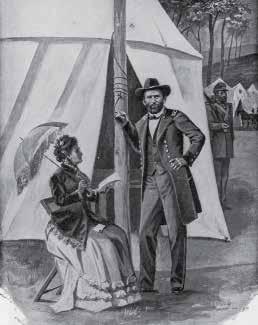
77 white house history quarterly BRIDGEMAN IMAGES
of the Civil War, Grant returned to the military, and Julia Grant, often with their children, visited camps. Grant wanted her with him as much as possible, and she shared the need to be together. Like Martha Washington, she tended to the soldiers and socialized with other officers’ wives. As Grant moved up the ranks and led his troops to victory, he was called to Washington and Mrs. Grant accompanied him. She met the Lincolns, and her participation in Washington society later proved to be an asset to her as first lady.
Mamie Doud’s father, unlike Julia Dent’s, encouraged her relationship with a young military officer, but, like the Dents, he expected her to live on an officer’s salary “unless it was a dire emergency,” says her biographer.7 Julia Grant did not know how to cook, and neither did Mamie Eisenhower, who, according to her granddaughter Susan Eisenhower, “was ill-prepared for even the most basic tasks of housekeeping” and the couple initially took their meals “at the officers’ mess across the street” until she learned some basics and her husband took over some of the kitchen duties.8 Mamie Eisenhower’s social background was an asset for Eisenhower as she adapted to army protocols and hosted the numerous gatherings expected of officers’ wives. Susan Eisenhower says that expectation for entertaining “created the necessity for a unique partnership between husband and wife. Mamie referred to the work she shared with Ike as ‘our career,’ and she was always conscious that, in her words, ‘a wife plays a very big part.’”9 That description would later apply to the Eisenhowers’ life in the White House.
COMMANDING THE PRESIDENT’S HOUSE AND THE WHITE HOUSE
Martha Custis’s home with her husband Daniel Custis was called White House; however, she is the only first lady not to live in the White House at 1600 Pennsylvania Avenue. The first two capitals of the new nation were New York and then Philadelphia. Martha Washington had the unenviable position of creating a role for the president’s wife. In doing so, she drew in part on her experiences during the Revolutionary War and her years of hosting visitors at Mount Vernon. A military career requires a partnership, and it was clear from the start that the presidency does as well. When Mrs. Washington arrived in New York she found that the president and his staff had plans for her to host dinners, regular receptions, and teas. The Washingtons’ informal

levees were open to all guests so long as they were “dressed appropriately,”10 thus supporting the republican values that made leaders more accessible and citizens participants in government. During the Revolutionary War, Martha Washington was exposed to new parts of the country and to people from backgrounds vastly different from her own, and she was comfortable welcoming soldiers, officers, and people on all social levels.
Just as she was concerned for the general’s well-being when she was in camp, Martha Washington was concerned about the president’s well-being when she was first lady. Shortly after he assumed the presidency, Washington needed a tumor surgically removed, and Mrs. Washington made certain he received the rest he needed. During his convalescence she served as his representative at General Nathanael Greene’s funeral in a demonstration of presidential partnership.11 Part of maintaining the president’s well-being was ensuring that he had time to escape the demands of office and be above
78 white house history quarterly
Unlike Martha Washington and Julia Grant, Mamie Eisenhower never visited her husband in combat zones.
DWIGHT D. EISENHOWER PRESIDENTIAL LIBRARY, MUSEUM, AND BOYHOOD HOME
General Eisenhower is pictured here in North Africa reading a letter from Mamie with her framed photograph nearby, 1943.
below
In his 1861 painting, The Republican Court (Lady Washington’s Reception Day), Daniel Huntington created a romanticized version of a 1789 reception at the President’s House, which he imagined to be as grand as an elaborate European palace. While the details may not be realistic in this work, Mrs. Washington regularly hosted receptions and teas in the President’s House in New York and then in Philadelphia during her years as the nation’s first first lady.
with friends and family. Mrs. Washington had two surviving children from her first marriage. Then daughter Patsy died at Mount Vernon of a seizure at age 17, and after son Jack died from camp fever in 1781 following the Battle of Yorktown, two of his children came to live with the Washingtons, and grandchildren were an important part of their lives. While a military marriage is a unique partnership, there are limits to a spouse’s involvement in military affairs. Says Susan Eisenhower, “Wives were expected to stay at arm’s length and tend only to domestic matters.”12 Until recent times, presidential wives avoided any public involvement in politics, and Martha Washington set the standard by not publicly commenting on anything political.
During the war, Mrs. Washington was called Lady Washington, and a unit of soldiers called themselves Lady Washington’s Dragoons. She understood firsthand the sacrifices soldiers made to win the nation’s independence, and she demonstrated her appreciation as first lady by opening her doors to regular visits from veterans. She also was known to “dole out cash,” says her biographer, and
to “intervene with her husband to grant pardons or bestow leniency on those in legal trouble.”13 First ladies to the present time have followed Martha Washington’s lead in being attentive to veterans’ needs during both wartime and peace.
Martha Washington’s interpretation of the role of a presidential wife growing out of her experiences as a general’s wife is reflected in the approaches of both Julia Grant and Mamie Eisenhower. Julia Grant, like Martha Washington, saw the realities of war, and she was equally dedicated to veterans. “At no time in the history of the White House,” says one biographer, “did so many soldiers call on the President. Julia always gave a specially warm welcome.” The Grant White House, says this biographer, ran on “military habits” and was “a clockwork regime.”14 Upon their arrival, Mrs. Grant said she “found the White House in utter confusion.” Through a series of personnel changes “order soon came out of chaos, and by autumn the house was in beautiful condition.”15 Julia Grant achieved order through rearranging furniture, repurposing rooms, and giving “orders” to staff. She wrote, sounding
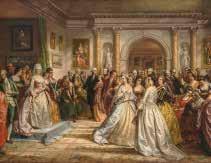
79 white house history quarterly
THE BROOKLYN MUSEUM
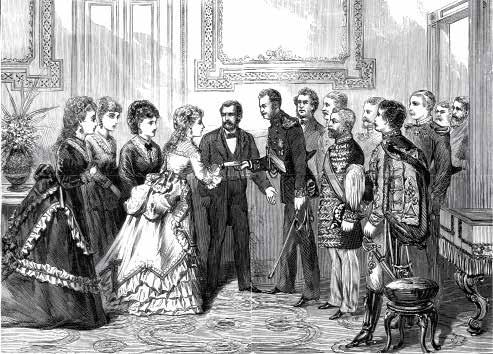
left Grand Duke Alexei Alexandrovich of Russia is presented to President and Mrs. Grant in the Red Room of the White House, 1871. The ladies beside Mrs. Grant assist with the introductions. Reception lines during the Grant presidency were organized with military precision and attention to rank.
below President and Mrs. Grant are pictured by Currier and Ives in the White House with their four children, 1869.

80 white house history quarterly TOP: WHITE HOUSE HISTORICAL ASSOCIATION / BOTTOM: ALAMY
below President and Mrs. Eisenhower greet wounded veterans who file by in a receiving line during a White House garden party, 1956.
like a general herself, that “these men were both astonished and chagrined when they received orders that thereafter they must appear in dress suits and white gloves. They must take their meals at home [rather than eating in the front entrance] and would not be allowed to smoke while on duty at the Mansion; any infringement of the above orders would meet with instant dismissal.”16 While she expected order, Mrs. Grant also took a personal interest in staff and gave financial and investment advice that resulted in one staff member becoming wealthy through real estate purchases the first lady suggested.
Just as the Washingtons’ entertainment was in keeping with republican values, the Grants’ “functions were truly republican in feeling,” says a biographer of Julia Grant. “The idea soon spread that the girl who worked in the printing office and wore alpaca was just as welcome a guest as the Worth-gowned pearl of fashion. . . .The diplomatic corps rolled up in fancily upholstered carriages. The working girls arrived in the new street cars.”17 However, the reception lines were organized with
military precision and attention to rank. Mrs. Grant elevated the role of cabinet and diplomats’ wives by having them stand with her at receptions. This decision reflected the importance of the wives in the administration, but it also assisted Mrs. Grant, who suffered from strabismus, or crossed eyes, which made it difficult for her to see who was approaching. The wives would prompt her with a name. She described the reception line protocol: “Mrs. Fish, wife of the Secretary of State, would stand near me while the members of the diplomatic corps were passing; and when the officers of the army and navy were passing, the ladies whose husbands were heads of these departments would, by previous invitation and arrangement, come to my side, and the lady who preceded her would retire.”18 The Grants were known for elegant entertaining, and Mrs. Grant’s background both personally and in the military well prepared her for protocol and diplomacy.
Mamie Eisenhower was not a direct observer of war, as Martha Washington and Julia Grant had been, but, according to her biographer, “she
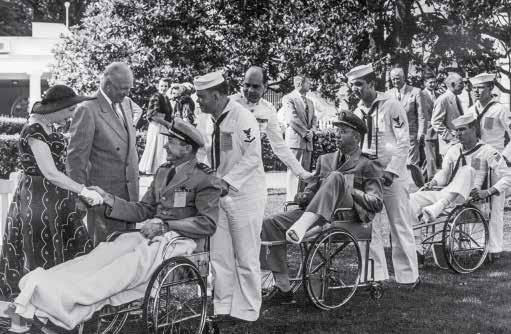
81 white house history quarterly
DWIGHT D. EISENHOWER PRESIDENTIAL LIBRARY, MUSEUM, AND BOYHOOD HOME
volunteered with the Army Relief Society, American Women’s Voluntary Service, and the United Service Organization (USO)” during World War II.19 While the Eisenhowers were in the White House, many of the president’s military friends were visitors at both private and public functions. The Eisenhowers hosted garden parties for disabled veterans, a tradition started by First Lady Edith Wilson but discontinued during World War II and resumed by the Trumans. Mamie Eisenhower added another reception for Washington, D.C., area institutions that included the U.S. Soldiers’ Home.20
Mamie Eisenhower’s years as a military wife, says her granddaughter Susan, “proved to be outstanding preparation for being First Lady. Many of the tricks Mamie had used to ease their earlier moves from one place to another worked well under these new circumstances.”21 J. B. West, chief usher to several presidents, noted, “As the wife of a career army officer, she understood the hierarchy of a large establishment, the division of responsibilities, and how to direct a staff. She knew exactly what she wanted . . . as if it were she who had been the five-star general.”22 Like Julia Grant, Mamie Eisenhower also understood that staff were crucial to an efficiently run White House, and she took particular care to acknowledge them. She had a cake made for each person’s birthday that they could take home along with a note from her, and she began the tradition of a staff and family holiday party. Her experiences of stretching Ike’s paycheck also influenced how she ran the White House. During the Truman administration the White House was essentially rebuilt, but, says a biographer, “the third floor was not completely finished, and there was not much money left . . . for decorating. She improvised by purchasing parachute silk . . . and had a White House seamstress make draperies for the third-floor windows. . . . [She even called] the head of a department store, who must certainly have been startled to take an order from the first lady.”23 She was also known to have a limit on personal expenditures for food and served dinner leftovers for lunch.
Like Martha Washington, Mamie Eisenhower maintained a hands-off approach to her husband’s work and to taking public stances on issues. She entered the Oval Office four times in eight years and only by invitation. She explained, “A wife never went near headquarters. You never went to his place of operation.”24 Being nonpartisan is deeply rooted

in the military, and Mrs. Eisenhower’s approach to entertaining reflected that background. She invited diverse groups and a wide array of guests, organizations, and entertainers to the White House and disregarded political affiliations. Like Martha Washington and Julia Grant, Mamie Eisenhower was a full partner in the presidential enterprise as she had been in the military, using the hostess role for diplomacy and to support her husband.
THREADS THAT CONNECT THEM
Current First Lady Jill Biden summarized the role of first lady well: “The unique paths first spouses choose reflect who we are but also the presidencies we serve and the times in which we live.”25 Who a person is results from the myriad of experiences in one’s life. For three first ladies who shared a common background as generals’ wives, the influence of military life is significant and seen in the similar ways they served their country as first lady.
above
First Lady Mamie Eisenhower made sure that no staff or family birthdays were forgotten in the White House. Here her grandson David blows out the candles on his birthday cake, 1956. Cowboy and actor Roy Rogers (far left) and his wife, actress Dale Evans (far right) join the celebration .
82 white house history quarterly GETTY IMAGES
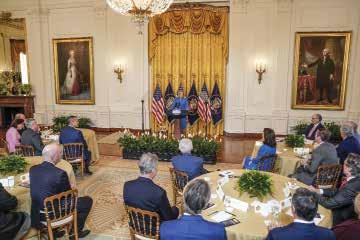
above
First Lady Jill Biden speaks in the East Room with First Lady Martha Washington’s official portrait behind her, 2024. The first of the generals’ wives to serve in the role of first lady, Martha Washington is remembered in the White House with this portrait by Eliphalet Andrews, 1878.
notes
1. Martha Washington to John Dandridge, April 20, 1789, The Papers of Martha Washington, ed. Martha Washington Papers Editors (Charlottesville: University of Virginia Press, 2022), 174.
2. Julia Dent Grant, The Personal Memoirs of Julia Dent Grant (Mrs. Ulysses S. Grant), 45th anniversary ed., ed. John Y. Simon (Carbondale: Southern Illinois University Press, 2020), 171.
3. Quoted in Marilyn Irvin Holt, Mamie Doud Eisenhower: The General’s First Lady (Lawrence: University Press of Kansas, 2007), 51–52.
4. Diana Bartelli Carlin, “Martha Washington: Southern Influences in Shaping an Institution,” in Southern First Ladies: Culture and Place in White House History, ed. Katherine A. S. Sibley (Lawrence: University Press of Kansas, 2020), 19.
5. “The Wrong Side of the Tracks,” chap. 11 of Dreams of a Barefoot Boy, 2017, available online at the Dwight D. Eisenhower Presidential Library, Museum, and Boyhood Home website, www.eisenhowerlibrary.gov.
6. Patricia Bailey, Martha Washington: An American Life (New York: Penguin Books, 2005), 119.
7. Holt, Mamie Doud Eisenhower, 8–9.
8. Susan Eisenhower, Mrs. Ike: Memories and Reflections on the Life of Mamie Eisenhower (New York: Farrar, Straus and Giroux, 1966), 45.
9. Ibid., 63.
10. Carlin, “Martha Washington,” 25.
11. Gene Procknow, “Alexander Hamilton’s Eulogy of Nathanael Greene,” posted October 19, 2017, Researching the American Revolution website, https://researchingtheamericanrevolution. com.
12. Eisenhower, Mrs. Ike, 64.
13. Carlin, “Martha Washington,” 26.
14. Ishbel Ross, The General’s Wife: The Life of Mrs. Ulysses S. Grant, 2nd ed. (West Columbia, S.C.: Arcadia Press, 2019), 110.
15. Grant, Personal Memoirs, 174.
16. Ibid., 174.
17. Ross, General’s Wife, 108.
18. Grant, Personal Memoirs, 175.
19. Holt, Mamie Doud Eisenhower, 33.
20. Ibid., 103.
21. Eisenhower, Mrs. Ike, 275.
22. J. B. West, Upstairs at the White House: My Life with the First Ladies (New York: Coward, McCann and Geoghegan, 1973), 130.
23. Diana B. Carlin, Anita B. McBride, and Nancy Kegan Smith, Remember the First Ladies: The Legacies of America’s HistoryMaking Women (Solana Beach, Calif.: Cognella Press, 2024), 161.
24. Quoted in Holt, Mamie Doud Eisenhower, 69.
25. Jill Biden, foreword to Diana B. Carlin, Anita B. McBride, and Nancy Kegan Smith, U.S. First Ladies: Making History and Leaving Legacies (Solana Beach, Calif.: Cognella Press, 2024), xvii.
83 white house history quarterly
GETTY IMAGES













